How to Build Brand Equity on Amazon: A Performance-First Guide
Learn how to build brand equity with data-backed tips. Discover effective tactics to boost your brand's value and drive eCommerce success.
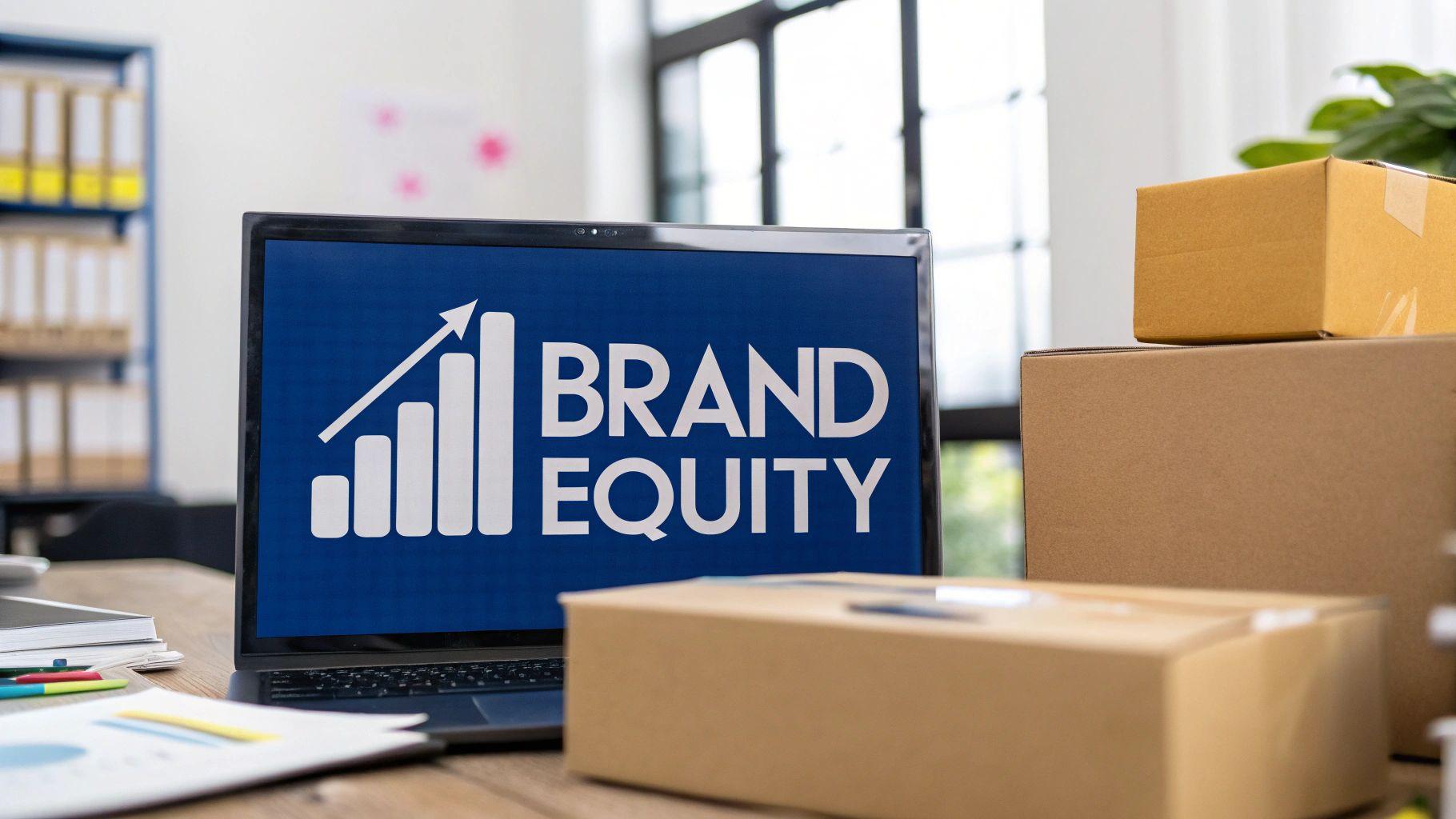
Building brand equity isn't a "soft" marketing initiative. It’s a direct investment in your financial health, giving you the power to command premium pricing, boost customer lifetime value, and insulate your business from price wars. For eCommerce leaders, the endgame is clear: build a brand so strong that customers search for you by name, driving profitable, organic growth and reducing long-term reliance on paid media.
This isn't about fluff. This is about building a measurable asset that drives sustainable scale.
What Brand Equity Actually Means for Your Bottom Line
Let's cut the textbook definitions. For an eCommerce leader, brand equity isn't a fuzzy metric tracked in social media likes. It's a tangible financial asset that directly impacts profitability and market position. It’s the commercial value baked into customer perception, created from every interaction, ad, and product experience.
On a performance-driven marketplace like Amazon, this value manifests in concrete ways. A brand with high equity doesn't just win one sale; it earns the next five. Customers stop searching for "running shoes" and start searching for "Brooks running shoes." That shift from generic to branded search is the entire game—it’s the difference between competing on price and building an enterprise on loyalty.
The Financial Power of Perception
Strong brand equity is a competitive moat. Customers who trust your brand are not only willing to pay more, but they’re also more likely to forgive a minor fulfillment error and become evangelists for your next product launch. This translates directly into healthier margins, predictable revenue, and a lower cost of doing business.
The data is clear: consumer perception is a leading indicator of financial performance. Take the battle between Anker and its unbranded competitors in the portable charger category on Amazon. Anker built its equity on reliability and stellar reviews. As a result, they can command a 20-30% price premium over generic alternatives and still dominate sales. Customers aren't just buying a charger; they're buying the certainty that it will work. That certainty is brand equity, and it's built one five-star review at a time. You can read more on the predictive power of brand equity in this fascinating analysis.
This infographic lays out the core financial benefits that stem from a powerful brand.
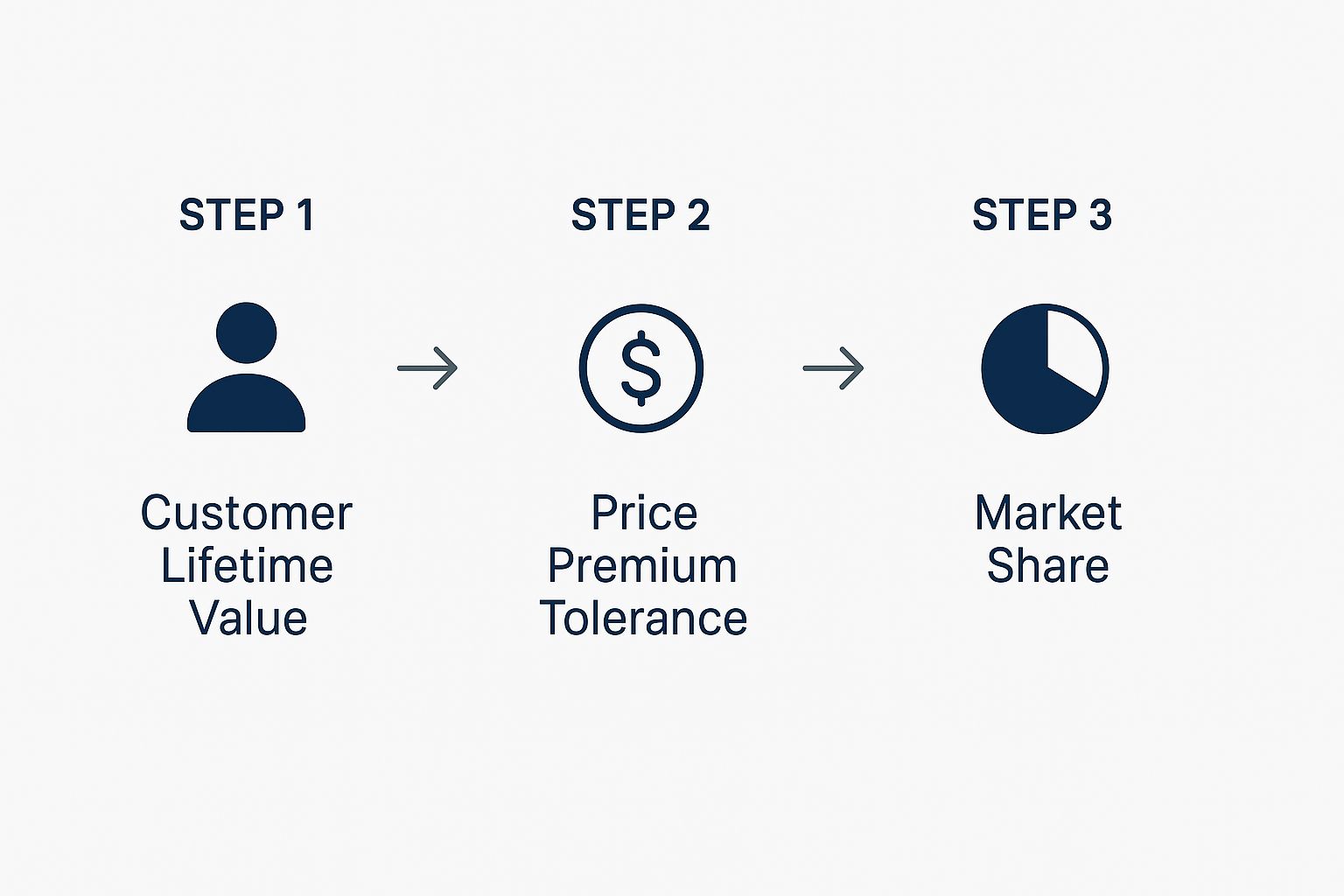
These pillars don't exist in a vacuum. They create a performance flywheel where increased loyalty drives higher margins, which can be reinvested into advertising that builds more awareness, creating a cycle of profitable growth.
Connecting Brand Equity to Your KPIs
Every dollar invested in brand must deliver a quantifiable return. The strategic shift is from chasing short-term sales spikes to creating durable, long-term value.
Here's how brand equity directly impacts the performance indicators your C-suite cares about:
- Lower Customer Acquisition Cost (CAC): As branded search volume increases, your reliance on expensive, top-of-funnel generic keywords decreases, driving down your blended CAC.
- Higher Customer Lifetime Value (CLV): Loyal customers repeat purchase, increasing the total profit you generate from the initial acquisition cost.
- Improved Advertising Efficiency (ROAS/TACOS): Ads for trusted brands consistently see higher click-through rates (CTR) and conversion rates, making every dollar of ad spend more productive. Our guide on how to calculate marketing ROI can help you measure this impact more precisely.
This table connects the components of brand equity directly to financial outcomes.
Brand Equity Levers and Their Financial Impact
| Brand Equity Component | Key Performance Indicator (KPI) | Direct Financial Impact |
|---|---|---|
| Brand Awareness | Branded Search Volume, Share of Voice (SOV) | Lower Blended Customer Acquisition Cost (CAC) |
| Brand Loyalty | Repeat Purchase Rate, CLV | Increased Revenue, Higher Profit Margins |
| Perceived Quality | Product Reviews & Ratings, Return Rate | Ability to command premium pricing |
| Brand Associations | Customer Surveys, Social Mentions | Higher Conversion Rates, Market Share Growth |
This isn't about spending more; it's about investing smarter. Investing in brand is a direct lever for a more profitable and defensible business.
The Takeaway: Stop viewing brand building as a cost center. It is one of the most powerful strategic investments you can make to improve marketing efficiency, increase profit margins, and secure long-term market leadership. Real brand equity isn't measured in buzz; it's measured in financial strength and sustainable growth.
The Three Pillars of Measurable Brand Equity
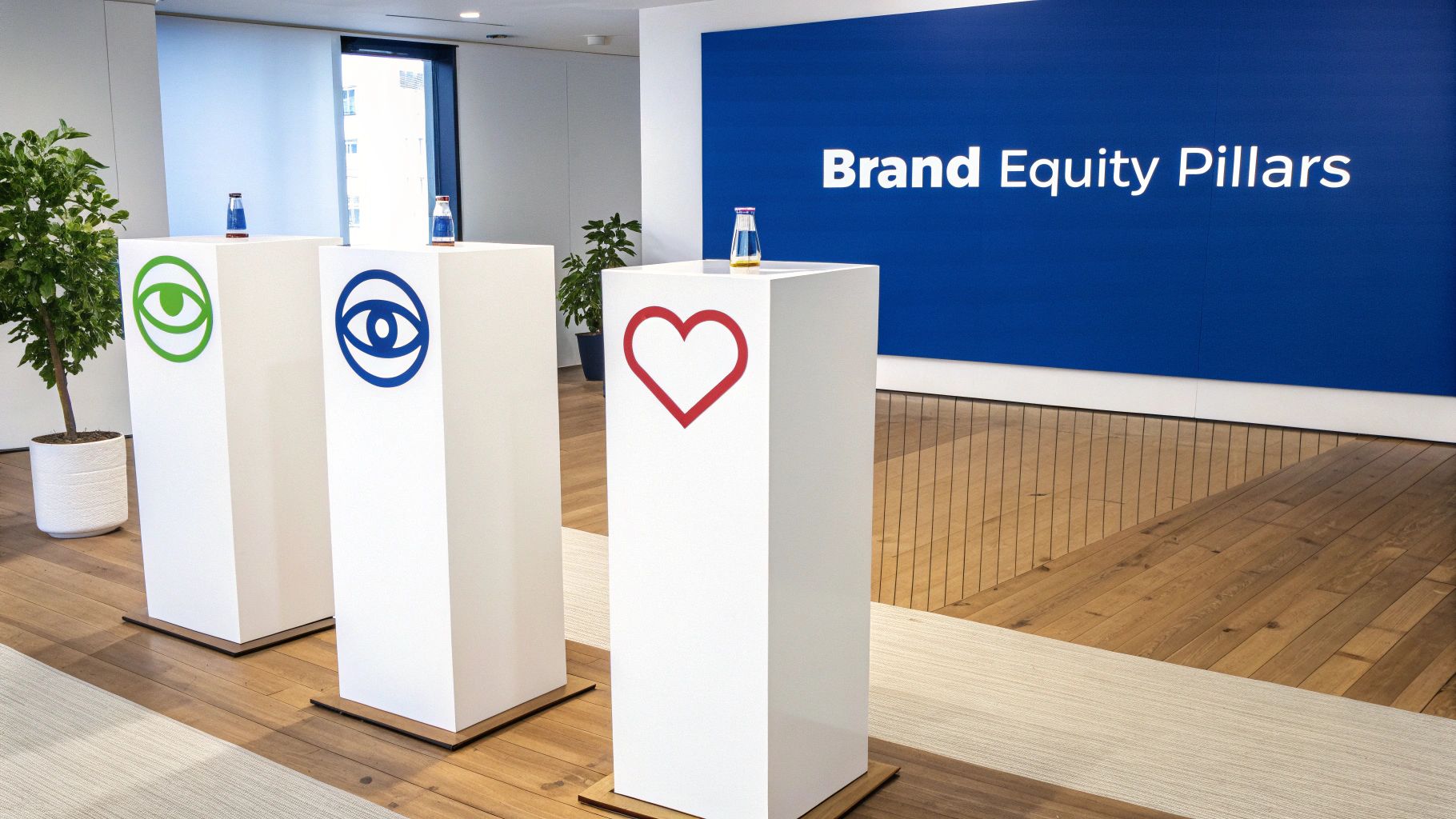
"Brand equity" can feel abstract, like trying to bottle lightning. But for any performance-focused leader, if you can't measure it, you can't manage it or justify the investment.
The key is to deconstruct brand equity from an intangible "vibe" into a dashboard of metrics you can actually track and influence.
We anchor our strategy on three core, measurable pillars: Brand Awareness, Brand Perspective, and Brand Attachment. This framework transforms the abstract into the actionable, giving you a clear scorecard for your brand's performance and a solid business case for your marketing spend. It's about making brand equity as tangible as your Return on Ad Spend (ROAS).
Pillar One: Brand Awareness
This is the foundation: do potential customers know you exist? Brand awareness measures how readily your brand comes to mind when a shopper has a need in your category.
We're not talking about vanity metrics like impressions. We need quantifiable signals of market penetration and mindshare.
- Branded Search Volume: This is a primary health metric. A rising number of shoppers typing your brand name directly into the Amazon search bar is a direct indicator that your brand-building activities are working. It signals a shift from discovery to intent.
- Share of Voice (SOV): This tells you how much of the digital shelf you truly own for your most critical keywords. Tracking your organic and paid rank against competitors provides an unfiltered view of your visibility. An increase in SOV directly correlates with an increase in market share over time.
Of all the things to focus on, building brand awareness is the essential starting point. It’s the bedrock of everything else.
Pillar Two: Brand Perspective
Awareness gets your foot in the door; perspective determines how customers feel once they're there. This pillar is about the sentiment and associations tied to your brand. Are you the premium, reliable choice, or the cheap, risky bet?
This perception has a direct and immediate impact on conversion rates and pricing power.
- Customer Reviews and Ratings: Your star rating is the table-stakes metric. The real intelligence is in the review text. Use sentiment analysis to identify recurring themes—positive and negative. This is unfiltered customer feedback on your brand promise.
- Amazon Questions & Answers: The Q&A section on your listings is a goldmine. The questions reveal customer friction points and information gaps. Your answers, viewed by thousands, shape your brand's perceived expertise and customer-centricity in real time.
Measuring brand equity is a complex but critical task. A survey of nearly 200 senior marketing managers revealed that only 26% found brand equity metrics very useful, highlighting the measurement challenge. This is precisely why breaking it down into awareness, perspective, and attachment is so crucial—together, they provide a holistic, actionable view of a brand's competitive strength.
Pillar Three: Brand Attachment
This is the ultimate goal: turning one-time buyers into repeat customers and advocates. Brand attachment measures the strength of the customer relationship and their propensity to choose you, even when a cheaper or more convenient competitor is one click away.
This is the pillar that drives customer lifetime value (CLV) and builds a truly sustainable, profitable business.
The Takeaway: High attachment means you’re not just renting customers with ads; you’re building a loyal asset that generates predictable revenue. This is where brand equity delivers its greatest ROI, breaking the cycle of perpetual paid customer acquisition.
- Repeat Purchase Rate: This is a hard, non-negotiable metric available directly in Amazon’s Brand Analytics. A high repeat purchase rate is concrete proof that your product and brand experience are delivering on their promise and creating genuine loyalty.
- Customer Lifetime Value (CLV): While challenging to track perfectly on Amazon, you can estimate CLV by analyzing repeat purchase data and average order value. A rising CLV is a clear indicator that your brand is successfully converting transactions into long-term relationships.
Using PPC as a Strategic Brand-Building Tool
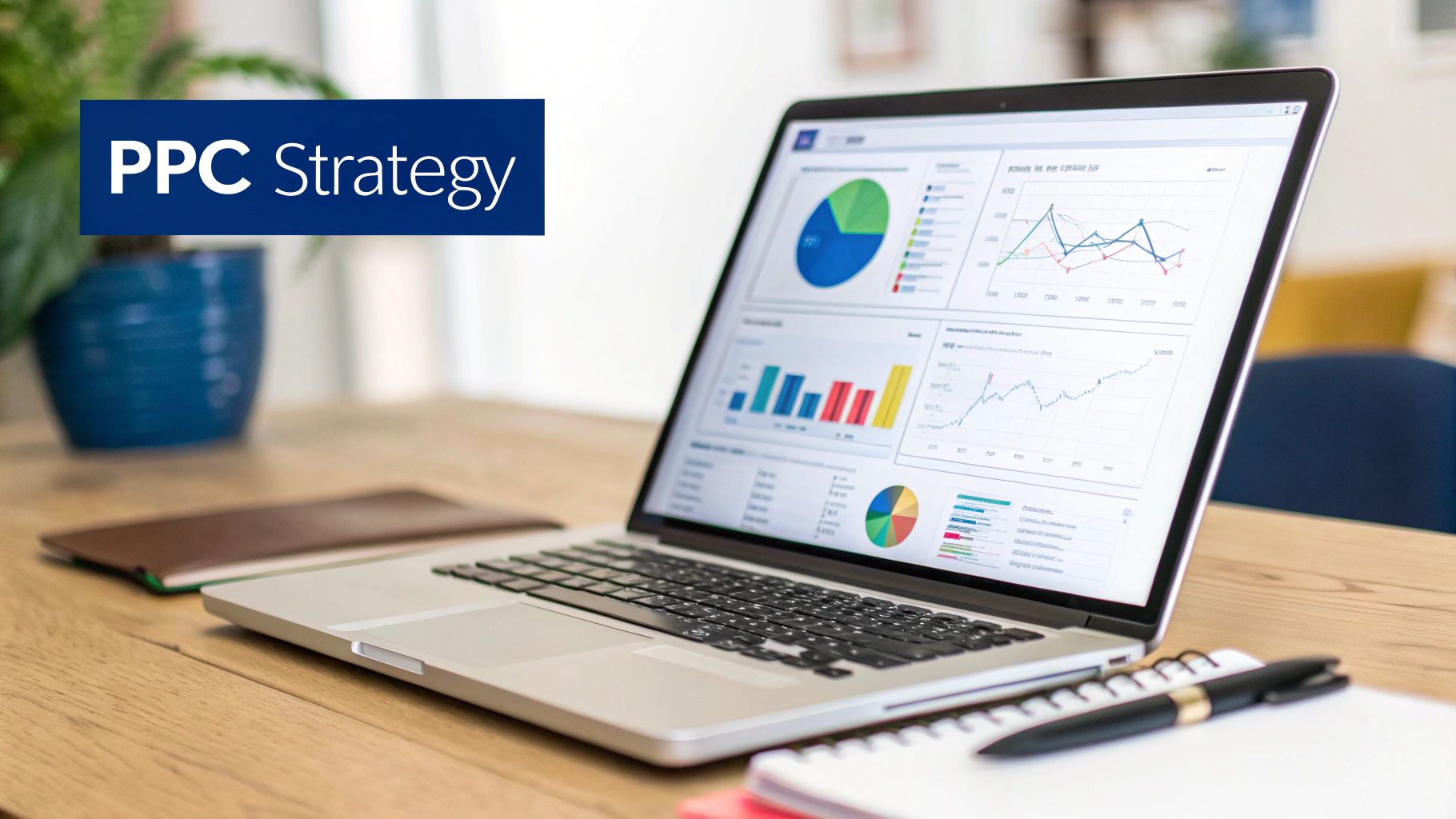
It’s time to challenge the outdated view of Pay-Per-Click (PPC) advertising. Too many brands treat it as a tactical, short-term sales driver, judged solely by its immediate return. This perspective misses the single greatest opportunity: leveraging PPC as a strategic, long-term engine for building measurable brand equity.
A performance-first approach to branding doesn't separate sales from awareness. It recognizes that intelligent ad spend creates a powerful flywheel. Every click and conversion can be engineered to do more than just generate a sale today; it can shape perception, dominate search visibility, and ignite a cycle of organic growth that pays dividends for years.
Stop treating PPC as a sales lever. Start deploying it as your primary brand-building weapon.
Dominate the Digital Shelf with Sponsored Brands
To build a brand, you must own your territory. On Amazon, that means owning the top of search, and Sponsored Brands campaigns are purpose-built for this. They place you in the premium, above-the-fold real estate, showcasing your logo, a custom headline, and a curated collection of your products.
This is more than advertising; it's high-visibility storytelling at the point of purchase.
A premium cookware brand, for example, can run a Sponsored Brands ad with the headline "The Last Pan You'll Ever Need," featuring their hero skillet, a Dutch oven, and a specialty saucepan. In an instant, they've shifted the conversation from a commodity purchase to a long-term investment in quality. This repeated exposure trains shoppers to associate your brand name with the category, turning their generic searches into branded searches over time—a clear sign of rising brand equity.
Shape Perception with Sponsored Display
Sponsored Display ads are your tool for extending the conversation beyond the search results page. These visual ads can appear on competitor product pages, category pages, and even off-Amazon, keeping your brand top-of-mind throughout the customer journey.
This is about proactive narrative control. For instance, a shopper viewing a competitor's listing for a skincare product can be served your Sponsored Display ad featuring superior creative, a "Dermatologist Recommended" badge, and better reviews. You've just intercepted a high-intent shopper and positioned your brand as the premium alternative. This consistent, targeted presence builds familiarity and trust, the foundational elements of loyalty.
Protect Your Turf with Defensive Campaigns
Building a brand is an offensive strategy, but it requires an impenetrable defense. Your competitors are actively bidding on your branded keywords, attempting to siphon off customers who are specifically looking for you.
Defensive campaigns are non-negotiable. By bidding on your own brand and product names, you achieve two critical objectives:
- You control the message. You ensure the first thing a loyal customer sees is your brand, with your messaging.
- You block competitors. You occupy the top ad slots, increasing the cost and difficulty for competitors to poach your hard-earned traffic.
Think of it as digital real estate. Not defending your branded search terms is like letting a competitor set up a pop-up shop inside your flagship store. It's an unacceptable risk to your brand equity. A deep dive into a holistic Amazon PPC marketing strategy can reveal more ways to weave these ad types together.
The Takeaway: Your ad spend is an investment in a balance sheet asset—your brand. Every dollar must pull double duty, driving sales today while building the equity that fuels tomorrow's organic growth. By using PPC to control your brand's narrative and defend your territory, you transform a tactical expense into a powerful, strategic growth engine.
Creating a Seamless Brand Experience on Amazon
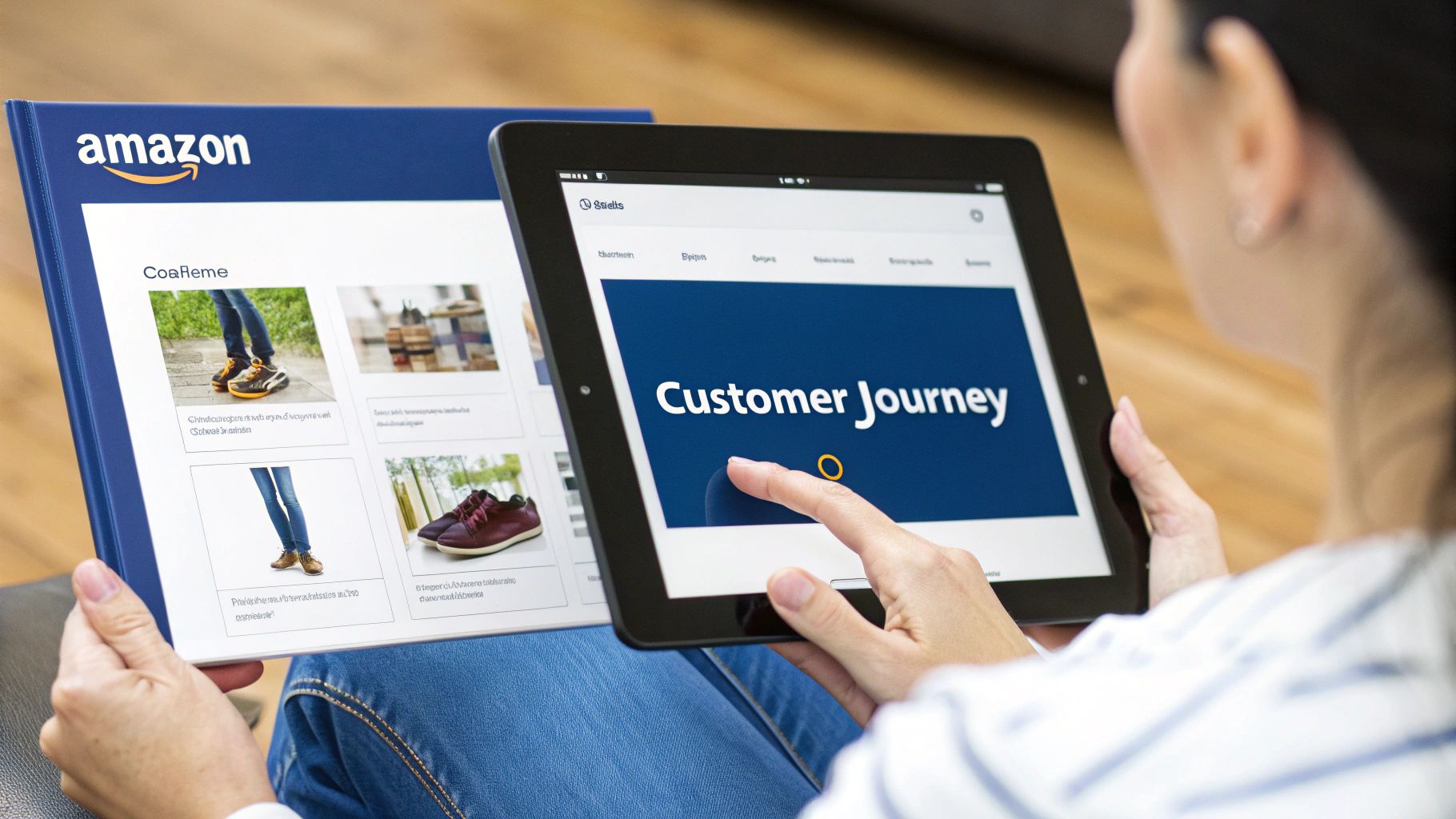
Brand equity is not built in a single moment. It is the cumulative result of every interaction a customer has with you. On a standardized marketplace like Amazon, creating a differentiated, consistent, and memorable brand experience is your primary lever for standing out and justifying a premium.
A slick ad that leads to a confusing product detail page or a generic storefront is a broken promise. It erodes the very trust you're trying to build. The objective is to architect a seamless customer journey where your brand's story, quality, and value proposition are reinforced at every touchpoint. This converts a simple transaction into a positive brand memory, earning the loyalty that underpins pricing power.
Turn Your Brand Store Into a Destination
Your Amazon Brand Store is not a simple product catalog; it's your flagship retail experience on the world's largest eCommerce platform. Treat it as your brand's home base—a controlled environment where you dictate the narrative, free from the distraction of competitor ads.
A well-architected Brand Store doesn't just display products; it immerses shoppers in your brand world. Use it to share your origin story, merchandise collections, and guide customers with lifestyle imagery and video. A brand selling baby products could create dedicated pages for "Newborn Essentials," "Feeding," and "Playtime," complete with buying guides and parent testimonials. This transforms shopping from a search task into a consultative experience. Directing Sponsored Brands traffic here creates a focused journey that deepens brand connection and measurably increases average order value.
Tell Your Story with A+ Content
Once a shopper is on your product detail page, A+ Content is your opportunity to move beyond functional bullet points. This is where you bring your brand to life, demonstrating not just what your product is, but why it's the superior choice. High-quality photography, benefit-led copy, and comparison charts work in concert to overcome purchase anxiety and justify your price.
Don't just list features; showcase outcomes. A company selling premium camping gear shouldn't just show a tent's technical specs. It should fill the page with immersive images of the tent in stunning landscapes, showing families enjoying the outdoors—connecting the product directly to the customer's aspirations.
The Takeaway: Your product detail page is your best salesperson, and A+ Content is its closing argument. Investing in professional, story-driven content is a direct investment in your conversion rate and your brand's perceived value.
This rich content not only educates and persuades but also builds the trust that 73% of consumers say is a deciding factor in their purchase decisions. For more on this, our guide to Amazon listing optimisation has practical strategies to get your pages converting better.
Build a Narrative with Posts and Video
The customer journey doesn't end on your product page. Tools like Amazon Posts and video allow you to maintain an ongoing dialogue in a more dynamic, social media-style format.
Posts are a free and effective tool for building an audience directly on Amazon. They appear on your product pages and in a dedicated brand feed, providing a platform to feature user-generated content, announce new products, or share lifestyle imagery. It's a low-effort way to stay top-of-mind and reinforce your brand's personality.
Video, meanwhile, is the most powerful storytelling medium available. Whether it's a 30-second spot in a Sponsored Brands ad or an explainer video on your listing, video can demonstrate a product in use, convey your brand's ethos, and create an emotional connection far more effectively than static assets.
Each element—Store, A+ Content, Posts, and Video—must work in concert. A cohesive execution creates the seamless experience required to build the brand equity that wins on Amazon.
Building Equity with Your Marketing Mix
Brand equity is not the result of a single viral ad or one killer product. It’s the cumulative effect of every marketing decision you make. It's time to view your marketing mix—advertising, promotions, and pricing—as an integrated system that either builds long-term value or erodes it for short-term gain.
Each component must be synergistic. A premium price point is undermined by cheap-looking ads. A constant stream of promotions negates the perception of quality you’ve spent years building. Aligning this mix is the key to creating durable brand value, not just temporary sales lifts.
Advertising Is Your Brand's Heartbeat
Consistent advertising is the most direct tool for building and maintaining mental availability with customers. This isn't about a massive Q4 push; it's about a sustained, "always-on" presence that ensures your brand is the default choice when a purchase need arises.
The evidence is overwhelming. There is a direct, causal link between sustained advertising investment and brand salience. A meta-analysis of over 1,800 academic papers on brand equity confirmed that marketing activities like advertising are direct precursors to building brand equity. If you're interested in the details, you can explore the full bibliometric analysis of brand equity research.
The implication is clear: your Amazon PPC campaigns are brand-building engines. Every impression reinforces your brand's position, making it a more familiar and trusted option in a saturated marketplace.
Promotions: The Double-Edged Sword
Promotions can be a powerful tool, but they must be wielded with strategic precision. Think of them as a potent prescription drug: used correctly, they can achieve specific objectives. Used carelessly, they can be toxic to your brand's health.
A strategic promotion can drive trial for a new product, generate buzz, or liquidate aging inventory. However, a chronic reliance on discounts trains your customers to devalue your product and wait for a sale. This erodes pricing power and can permanently shift your brand perception from "premium" to "discount."
Consider the difference:
- Equity-Building Promotion: An exclusive, time-bound "Prime Day Deal" on a new product. This creates urgency and rewards loyal customers without setting an expectation of perpetual sales.
- Equity-Eroding Promotion: A persistent "20% Off" coupon on your flagship product. This devalues the item and signals to the market that it isn't worth its full price.
Use promotions as a scalpel, not a sledgehammer.
Your Price Is Your Promise
On Amazon, your price is one of the most powerful signals of your brand's quality and market position. A premium price communicates confidence and value. A low price often implies a compromise in materials, quality, or service.
In a marketplace where shoppers can compare dozens of options in seconds, your pricing tells a story. That story must be consistent with your A+ Content, your advertising creative, and your packaging.
The Bottom Line: Your marketing mix is a delicate ecosystem. Advertising builds familiarity, promotions create urgency, and pricing signals value. When these elements are misaligned, you send conflicting messages that weaken your brand. A cohesive strategy ensures every dollar spent reinforces the durable, premium brand you're working to build.
To see how these decisions play out, let's look at how different approaches can either build your brand up or tear it down.
Marketing Mix Impact on Brand Equity
This table provides a clear, side-by-side comparison of how common marketing activities impact your brand’s long-term value.
| Marketing Element | Equity-Building Approach (Example) | Equity-Eroding Approach (Example) |
|---|---|---|
| Advertising | Consistent, always-on brand awareness campaigns using Sponsored Brands to own top-of-search. | Sporadic, sales-focused campaigns that only run during peak holidays, disappearing otherwise. |
| Promotions | Strategic, limited-time offers like a Prime Day exclusive to drive trial and excitement. | Constant, deep discounting and "always-on" coupons that train customers to never pay full price. |
| Pricing | Maintaining a premium price point justified by superior A+ Content, reviews, and brand story. | Engaging in price wars with competitors, constantly lowering prices to win the Buy Box. |
Ultimately, every marketing decision must be audited through the lens of brand equity. Before launching a campaign or creating a coupon, ask the critical question: does this action enhance our perceived value, or does it trade long-term brand strength for a short-term sales spike? The answer will guide you toward profitable, sustainable growth.
A Few Common Questions About Brand Equity
When it comes to building brand equity on Amazon, theory often collides with hard operational realities. Generic marketing advice doesn't always apply. Let's cut to the chase and address the no-nonsense questions we hear from brand leaders.
How Long Does This Actually Take?
Let's be direct: there is no magic timeline. Building real brand equity is a marathon, not a sprint. Expecting rapid results is a recipe for strategic failure.
You can see leading indicators within months of a concerted effort—an uptick in branded search volume, improved CTR on ads, a better ratio of organic to paid sales. But building the deep-seated loyalty that turns customers into advocates? That takes years of relentless consistency in messaging, product quality, and customer experience.
Think of it like a 401(k). Your initial investments in great creative and a seamless customer journey are the early contributions. Every positive review, every memorable ad, and every hassle-free return compounds over time.
The single biggest mistake is inconsistency. We've seen brands cut back on brand-building investments during a soft quarter, only to find it exponentially harder and more expensive to regain that lost momentum. An "always-on" presence is not a buzzword; it's a fundamental requirement for building a durable asset.
Can We Do This With a Small Budget?
Absolutely. Building a powerful brand is more about strategic focus and consistency than sheer budget size. For brands without a massive war chest, the key is ruthless prioritization.
Forget trying to be everything to everyone. Your objective is to dominate a profitable niche.
- Zero in on your core audience. Identify your most valuable customer segment and architect an entire brand experience that resonates deeply with them.
- Defend your brand name. Allocate a portion of your budget to defensive PPC campaigns on your own branded search terms. This is often the highest-ROAS spend in your entire account.
- Leverage free tools. Amazon provides powerful brand-building assets. Maximize your use of Amazon Posts, create best-in-class A+ Content, and build a Brand Store that tells a compelling story. This is where sweat equity delivers outsized returns.
A tighter budget forces creativity and discipline, which often results in a more authentic and potent brand identity.
What's the Single Biggest Mistake Brands Make?
In one word: inconsistency. It is the fastest path to eroding brand trust, and it manifests everywhere. Messaging shifts from premium quality one quarter to deep discounts the next. Pricing fluctuates wildly. Ad creative is polished, but the product page is sloppy.
View this from the customer's perspective: they see a sophisticated ad, click through, and land on a product page with blurry images and typos. This disconnect creates immediate doubt and cheapens the entire brand perception. To build equity, every single touchpoint—from the first ad impression to the post-purchase follow-up—must reinforce the same brand promise.
How Does PPC Really Help Build the Brand?
Many sellers remain stuck in the mindset of PPC as a direct-response sales machine, judged solely by ACOS or ROAS. This is a dangerously narrow view that misses its strategic value. Deployed correctly, PPC is one of the most powerful brand-building instruments on Amazon.
When you use a Sponsored Brands ad to dominate the top of search, you are not just fishing for a click—you are making a public declaration that you are a leader in the category. When you use Sponsored Display to appear on a competitor's product page, you are actively inserting your brand into the customer's consideration set at a critical moment.
This sustained, targeted visibility builds mental availability. It creates the cognitive real estate that is the very definition of brand equity. For those looking to push the envelope, you can explore other ways of Driving Engagement and Brand Awareness with Richly AI to complement your core PPC strategy.
At Headline Marketing Agency, we believe ad spend is not an expense; it's a strategic investment in your brand's future value. We architect data-driven PPC strategies that don't just capture today's sale but build the brand equity that secures your long-term profitability and market dominance.
Wollen Sie Ihre Amazon PPC-Performance aufs nächste Level bringen?
Lassen Sie Ihre Amazon PPC-Kampagnen professionell analysieren und entdecken Sie neue Wachstumsmöglichkeiten.